City of Norfolk Sweeping Program Targets Chesapeake Bay Protection |
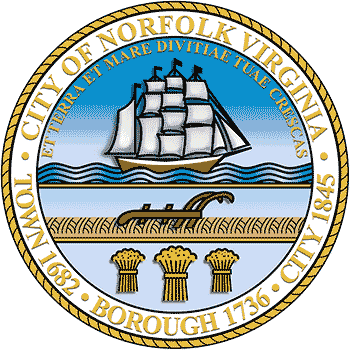
The City of Norfolk, Virginia, is the urban center of Hampton Roads with a total population of approximately 247,000 residents. The City managers are responsible for sweeping 1,900 curb miles per month via an extensive program that includes daily sweeping to monthly sweeping.
Street sweeping techniques and best practices are have come under greater scrutiny in recent times since the area is under the oversight of the 2012 Chesapeake Bay Total Maximum Daily Load (TMDL) requirements, as well as the standard USEPA Stormwater Phase I and II guidelines. As a result, Norfolk city managers have been moved toward the leading edge of investigation toward the best management practices when it comes to utilizing sweepers as the first line of defense in minimizing stormwater runoff pollution.
by Ranger Kidwell-Ross
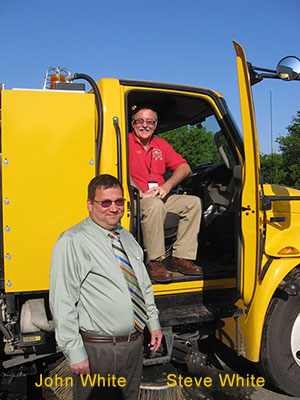 The information from this article is taken from an interview with John White, stormwater engineer for the City of Norfolk; and, Steve White, superintendent for street sweeping operations for the City.
The information from this article is taken from an interview with John White, stormwater engineer for the City of Norfolk; and, Steve White, superintendent for street sweeping operations for the City.
The City of Norfolk sweeps every curbed street in the city at least monthly. The downtown business area, which is a several square mile area, is swept on a nightly basis. Where the City sweeps monthly, the current protocol regarding parking is that car removal is required for all of the more congested neighborhoods. In those areas, the City sweeps one side of the street only on a given sweeping day. This lets residents move their cars to the other side of the street on sweeping days, which minimizes the problem of where to put cars.
The regulations in those areas allow ticketing of cars that are not moved. However, in the neighborhoods where parked cars are less of a problem the City posts advisory signs. Car removal on sweeping days is not mandated in those areas.
Historically, the City has operated mechanical broom sweepers, which included 14 Elgin Pelican NP-series machines. Recently, learning that data shows the likelihood of better small-micron pickup with air sweepers, the City has recently purchased three new TYMCO model 500X air sweepers.
In addition, the City operates several Tennant 'golf cart-sized' sweepers in the downtown core to clean in the highest traffic areas. These provide the maneuverability needed to keep streets in the dense city core cleaned.
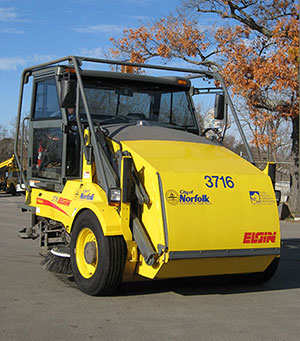
When asked if any differences have been noted to date between the sweeping capabilities between the City's broom and air sweepers, John White pointed out what Norfolk's management team observed after a late winter snowfall. Although enough snow fell to require a substantial amount of salt and sand to be put down, within a couple of days the snow was all gone.
Unlike the previous results with the mechanical broom sweepers, John says, when they ran the regenerative air sweepers down the major highways they couldn't even see that any material had been put down. That was, both Whites agreed, a substantial difference in their previous broom sweeper experience in the same type of situation.
As many reading this article may already know, air sweepers have been shown to be considerably more effective at removing small-micron materials, which is where the majority of pollutants targeted for removal are attached. Given the added environmental guidelines the City of Norfolk is under, having such a cleaner result is definitely seen as a plus.
Although both air sweepers and mechanical broom models do a good job at removing larger material, especially when it comes to material 250 microns and smaller studies have shown that air sweepers have a commanding advantage. Why is that very important from an environmental perspective? Even though only about 10% of the total loading of a typical city street is composed of material 250 microns or less, up to 60% of the total pollutant loading of the street may be contained in that 10% of material.
That's why, when it comes to overall cost per pound of pollutant removed from a typical stretch of pavement, air sweepers appear to have a cost per pound of about half that of a broom sweeper. In an area positioned on a significant waterway – like the City of Norfolk where pollutant runoff ends up in Chesapeake Bay – it is particularly important to have a well-organized sweeping program, one with the correct make-up of sweeper types managed so that they sweep at an optimal frequency.
"Fortunately," said Steve White, "the street sweeping program is very highly regarded in the City, both by our city council and by our citizens. It's a popular program that receives a lot of positive feedback. However, the aspect of improving water quality is probably the unsung hero in the equation.
With more citizen education and outreach, as the water quality aspects are brought out – especially given that our new seekers are better equipped to contribute to water quality improvement – our sweeping program's positive profile should increase even further. We are definitely looking to expand the role of our sweepers in order to be more effective in the pollutant removal process."
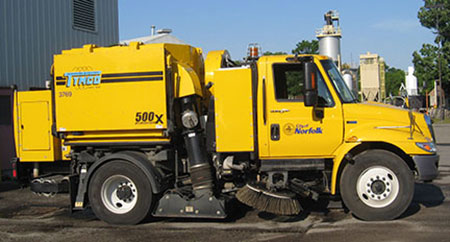
At this point, says John White, they are not intending to replace the City's broom sweeper fleet with all air machines. However, the TYMCOs were purchased specifically to enhance the ability of the City's sweeping program to address water quality improvement. The goal is to reduce both the amount of sediment and the amount of pollutants going into Norfolk's waterways. After doing the homework, City managers concluded that adding regenerative air sweepers to its fleet was a cost-effective way to do so.
The City of Norfolk has a stormwater utility, which pays for the maintenance and upkeep of the stormwater system. This includes paying for the street sweeping program. This unification of the sweeping and stormwater programs aligns with best management practices, since the combining of the budgets for both programs allows available funds to be allocated among the various TMDL/pollutant removal methods, including sweeping, as emerging data indicate should be done.
The streets and curbs in Norfolk's Downtown Business Center (DBC) are kept clean via a combination of the City's street sweeper fleet and several smaller Tennant sidewalk sweepers operated by DBC 'ambassadors.' The DBC's Tennant machines are smaller than those employed by the City; these are either walkbehind units or have a 'silky-type' seat attached. The intent of the DBC sweeping program is two-fold; to remove pollutants that might contribute to the TMDL count and to keep the area looking nice for the downtown business community.
Steve White says the TMDL requirements the City is under are part of a presidential Executive Order that was enacted in 2012. Since the program is just getting started it's too soon to tell how the City of Norfolk will fare under the tighter requirements. The first target date under the program is six years away, with a final target set for 2026. At that later date, the City of Norfolk and all the other communities under the TMDL requirements will have to be in compliance with the program's mandate.
Currently, the City is working to get the street sweeping program positioned as a Best Management Practice (BMP) for the TMDL program. At the moment, there are certain limits set out for what may be claimed for removal via the street sweeping portion of the City's activity. In the next few years, City sweeping managers will be documenting data to show the capability of its sweeping program to address the TDML issue. One area of emphasis will be to coordinate sweeping with work done by other departments in the City.
"Steve's team does an excellent job of working with all of the other parts of the City," said John White. "He has his team working closely with the utility department, streets and bridges, and so forth. For example, when anyone is doing anything that might put dirt onto the road, the sweeping department is really tied in in order to keep it cleaned up. We have a coordinated approach that works very well.
"In terms of extending the amount of street sweeping: We did conduct some studies with local consultants who did an analysis on the effectiveness of the street sweeping program. In addition to our normal testing, we also do sampling of the debris that's being picked up. This is done at a rate of collecting and testing a sample once per about every 100 tons of debris removed via our sweepers. We measure nutrient loading, which provides us with data that will help us see how we are meeting our TMDL removal requirements."
What the data has shown to date is consistent with what might be expected. In the spring and fall there are higher nutrient loadings, primarily due to citizen lawn fertilization activities. These pollutant loadings drop the rest of the year.
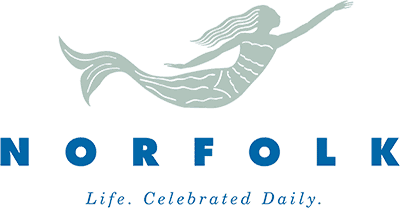
"We're pretty confident that – if we are allowed to reflect the true effectiveness of the sweeping program – we will be able to meet all of the requirements under the Chesapeake Bay TMDL with street sweeping alone," said John White. "Street sweeping is an effective tool for that. However, we are pursuing other activities, as well."
The City of Norfolk's move to add air sweepers to its fleet would appear to be a positive step in that regard, since small-micron particles are so much more polluted than larger ones – and air sweepers have been shown to do a significantly better job in their removal. Some studies have shown that an air sweeper, when employed on a street directly behind a mechanical broom machine, will typically pick up 500 or more pounds per curb mile, a debris load mostly comprised of the more pollutant-laden smaller-micron particles.
The Whites were asked if they have seen any larger amount of street debris coming from parking lots in recent years, during the time when the recession has caused the frequency of parking area sweeping to be reduced due to budget cuts for sweeping by the business community.
"That is something we have started to look at," said Steve White. "However, we have not started to do any testing designed to determine what is coming from parking lots. We do have an environmental staff that is expanding, given our increasing regulatory requirements, and they will be looking into a number of areas such as that. For example, they are investigating what the TMDL load appears to be from impervious surface areas. We also have environmental inspectors who go out to take a look at construction projects, new parking lots and so forth. If there's anything low-tech that they can pick up on and require, they will.
"Regrettably, much of our industrial area, including shipyards, are located right on the waterfront. Although many of these businesses are good corporate citizens, there is little doubt that a significant amount of pollutants may be going into the Chesapeake from that source. The other aspect is that of litter control: The City has begun a serious effort to control litter via working with corporate citizens to reduce the incidence of littering and to get the business community to become more cognizant of the relevant issues."
As part of the audio podcast portion of the interview with Steve and John White by WorldSweeper's editor, Ranger Kidwell-Ross, the latter related what he has learned about sweeping best practices both in the U.S. and during his travels around the world. The vital importance of employee training was emphasized, with examples of the relatively good training viewed by sweeping personnel in Copenhagen – where people are now able to swim in the canals after decades of not being able to do so due to a high pollutant level.
In contrast, Kidwell-Ross noted that even though Amsterdam required two employees with brooms to precede machine sweepers when next to the canals – which were still too polluted to swim in – instead of 'brooming' the debris away from the canal and toward the sweeper, they swept back and forth such that every other sweep moved debris into the canal! This and other information emphasize the importance of ongoing oversight being a part of employee management, in addition to initial training methods.
Likewise, the value of education teaching citizens about not overusing fertilizers, soaps and other chemicals for lawn care, car washing, etc., can play a major role in reducing the amount of pollutants that come off impervious surfaces. When these pollutants are allowed to flow into the streets, they often eventually make their way into the waterways of the region. The podcast also includes an analysis of why and how requiring cars to be moved prior to sweeping provides extensive value.
"Over the last six years," said Steve White, "when it comes to sweeping we've been part of an ever-changing process. We've done it in stages: We started off doing sweeping on a cycle of every six weeks; then, we moved to once per month. After that, we started introducing signs related to moving cars as part of a PR campaign to inform citizens.
"Our PR department has gone heavily into the civic leagues in the different neighborhoods, partnering with them and promoting the value of moving cars. We are doing all we can to educate citizens and the business community in and around Norfolk to understand what unhindered sweeping can do to preserve our water quality.
"We've done more outreach via working with our local newspapers and other media. We've put out flyers to homeowners and done our best in other ways to educate them, as well. As a result, sweeping has become quite a popular program with the citizens of Norfolk. Our City is cleaner and the expectation is for it to stay that way since our citizens now expect that to be the norm. If we miss a day of sweeping because of bad weather, for example, we get phone calls about it. That's the type of citizen knowledge, expectations and involvement we like to see."
Through this interview with the two individuals who are perhaps the most responsible for keeping the City of Norfolk and nearby Chesapeake Bay waterways as clean as possible, it is clear that an inordinate amount of pride is attached to doing an outstanding job. This commitment has been spread throughout the City's sweeping program. Norfolk's 25 sweeper operators and maintenance personnel, both Whites agreed, are a big part of the successes for the program to date. There are even laborers who go out with the sweepers to make sure any tight or dead-end areas where the sweepers aren't able to reach are swept clean and the litter collected.
The hand crews are also employed to clean any bridges, overpasses or other areas where a sweeper either cannot go or can't do a sufficiently thorough job. Half-a-dozen members of the City's engineering staff are also on board to help the street sweeping and stormwater department meet its goals in any way they can.
Sweeping support personnel are additionally employed to hang notices on doors when there will be stormwater department or other, related, construction activity in an area. As you will additionally hear in the podcast, the City provides internal credits for sweeper operators and others in the department who provide information about repairs being needed, streetlights out, etc. As this story illustrates clearly, the City of Norfolk is determined to become a leader in developing a comprehensive stormwater pollutant minimization program that utilizes the capability of street sweeping to its fullest degree. Norfolk is working on an ongoing basis to design a comprehensive, multi-agency effort that will maximize water quality throughout its surrounding area. This is an approach that offers ideas that other city managers would do well to emulate in their own communities.
Note: The following audio interview with John and Steve White will play without downloading any files onto your computer. If you hear the interview at 'chipmunk speed,' you will need to download the latest version of Adobe's free Flash player.
Note: To play the interview, click this link or on the small triangle inside the circle you see to the left. If you have any trouble accessing this audio, please let us know.
If you'd like to contact the City of Norfolk, call 757.823.4000 or use this link to send an email to John White.